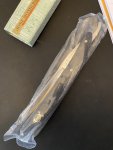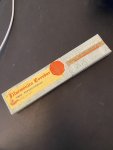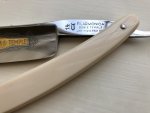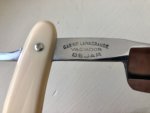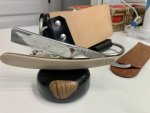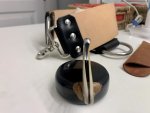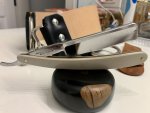Filarmonica.docx
1 / 3
1. First Generation: Jose Monserrat Pou's initial offerings - ~1915 - 1967.
Pre-1950 versions will NOT have "FABRICACION ESPAÑOLA / MADE IN SPAIN" stamped on the rear of the tang
Three main iterations of the "Especial" model (in order; transitional anomalies exist)
Tang shows curved Jose Monserrat Pou with stylized eagle (IMPERIAL brand), tall & vertical "14"
Tang shows IMPERIAL brand, straight Jose Monserrat Pou, short & horizontal "14" with lyre
Tang returns to curved Jose Monserrat Pou & tall/vertical "14", but with "FILARMONICA"
These would also have the 'musical' Especial/Filarmonica gold seal on the blade face
New white box with "Especial Para Barbas Duras" - the original EPBD
The original "Doble Temple"
Tang similar to Especial with curved Jose Monserrat Pou, tall & vertical "14", and "FILARMONICA"
A different gold seal on the face, most notable attribute being the "JMP" initials in the center
Collectors will refer to this as a "JMP signature blade", the initials were later replaced by the lyre
See my earlier image for a pristine example; these are more rare and more highly valued by some
The rest of the gold seal might have been generic; I've found a Carl Friedrich Ern Crown & Shield with the same seal design
The "Medallon Taurino" limited edition, bullfighting series was introduced
They're just Doble Temple 13s with six bullfighting themes on the face
Banderillas, Capote, Estocada, Cogida, Muleta, and Rejoneo
Three total iterations found across three generations of Filarmonica (anyone up to collect all 18?)
The "Sub Cero" was a cryo-treated Doble Temple. Tang stamp conventions apply. It stuck around into the next generations.
2 / 3
2. Second Generation: I call it the "Filarmonica Aesthetic Period" (FAP...fapfapfapfapfap...) - 1967-1979.
The company seems to have decided that pretty makes profit, and thus updated their look.
New scales (a few versions), gold seals, and tang stamps mark this era.
Tang stamps settled into a uniform style with small horizontal number, lyre, JMP, model, and Filarmonica
The Especial blossomed into the more ornate Especial Para Barbas Duras with laser etching and tang grommet.
The Doble Temple continued as the brand's steadfast workhorse, steady as she goes.
Four more models appeared
TRIDUR Especial Para Barbas Duras - Trivalent chromium coating for less corrosion. It's harder to hone until the outer coating is removed. Name is on the face, otherwise identical to the EPBD.
Novodur Para Profesionales - not much known, though the marketing goal is clear. Notable are the embossed scales from the EPBD, third pin in the scales, model on the tang, and gold seal similar to Sub Cero
Especial Para Corte de Pelo - narrow EPBDs made for hair cutting with attachment. "Corte Cabello" on the face.
INOX / INOXIDABLE - stainless steel Doble Temple. I don't like stainless, so not much to say there. Most were 3rd gen and don't bear JMP's name.
3. Third generation: Jose Monserrat Pou passed away sometime in the late '70s - early '80s. His son took over for a brief period, apparently continuing to sell out the old stock of materials. This is a murky period which I avoid. Straight razors were banned from Spanish barbershops in 1985 (Hepatitis & HIV?) and safety/cartridge razors had taken over worldwide, so the diminished demand (along with JMP's absence) had a direct affect on production. Many people have declared success with these razors, but they are considered hit or miss by collectors.
Key identifier is JMP's name having disappeared from the blades altogether
These are the razors you see in black "Sello Oro" boxes
3 / 3
Quality control was on the fritz with blade faces not matching tang stamps and other issues (lots of these on ebay from Japan)
4. Fourth generation: JMP's son died shortly after his father, then the daughter took over. The company closed a few years later in 1990.
Very hard, brittle steel sourced from Pakistan - takes an edge, but falls apart sooner than expected
No tang marks, only perfunctory "FILARMONICA -DOBLE TEMPLE-" etched on the face
Some have Sello Oro packaging or just plastic sleeves
Simply avoid these unless you're a collector
The first gen blades are considered by some to be the highest quality Filarmónica produced. I believe this is partially a matter of nostalgia, because when examining the first two generations historically & practically (on hones and face), there doesn't seem to be a difference between them with regard to steel and grinding. There is no reason that the earliest third gen razors shouldn't perform as well as previous generation blades, but any razor lacking Jose Monserrat Pou's name is a gamble. For those of you who got the good ones, congratulations! But caveat emptor to anyone on the hunt for a new Filarmónica.
1 / 3
1. First Generation: Jose Monserrat Pou's initial offerings - ~1915 - 1967.
Pre-1950 versions will NOT have "FABRICACION ESPAÑOLA / MADE IN SPAIN" stamped on the rear of the tang
Three main iterations of the "Especial" model (in order; transitional anomalies exist)
Tang shows curved Jose Monserrat Pou with stylized eagle (IMPERIAL brand), tall & vertical "14"
Tang shows IMPERIAL brand, straight Jose Monserrat Pou, short & horizontal "14" with lyre
Tang returns to curved Jose Monserrat Pou & tall/vertical "14", but with "FILARMONICA"
These would also have the 'musical' Especial/Filarmonica gold seal on the blade face
New white box with "Especial Para Barbas Duras" - the original EPBD
The original "Doble Temple"
Tang similar to Especial with curved Jose Monserrat Pou, tall & vertical "14", and "FILARMONICA"
A different gold seal on the face, most notable attribute being the "JMP" initials in the center
Collectors will refer to this as a "JMP signature blade", the initials were later replaced by the lyre
See my earlier image for a pristine example; these are more rare and more highly valued by some
The rest of the gold seal might have been generic; I've found a Carl Friedrich Ern Crown & Shield with the same seal design
The "Medallon Taurino" limited edition, bullfighting series was introduced
They're just Doble Temple 13s with six bullfighting themes on the face
Banderillas, Capote, Estocada, Cogida, Muleta, and Rejoneo
Three total iterations found across three generations of Filarmonica (anyone up to collect all 18?)
The "Sub Cero" was a cryo-treated Doble Temple. Tang stamp conventions apply. It stuck around into the next generations.
2 / 3
2. Second Generation: I call it the "Filarmonica Aesthetic Period" (FAP...fapfapfapfapfap...) - 1967-1979.
The company seems to have decided that pretty makes profit, and thus updated their look.
New scales (a few versions), gold seals, and tang stamps mark this era.
Tang stamps settled into a uniform style with small horizontal number, lyre, JMP, model, and Filarmonica
The Especial blossomed into the more ornate Especial Para Barbas Duras with laser etching and tang grommet.
The Doble Temple continued as the brand's steadfast workhorse, steady as she goes.
Four more models appeared
TRIDUR Especial Para Barbas Duras - Trivalent chromium coating for less corrosion. It's harder to hone until the outer coating is removed. Name is on the face, otherwise identical to the EPBD.
Novodur Para Profesionales - not much known, though the marketing goal is clear. Notable are the embossed scales from the EPBD, third pin in the scales, model on the tang, and gold seal similar to Sub Cero
Especial Para Corte de Pelo - narrow EPBDs made for hair cutting with attachment. "Corte Cabello" on the face.
INOX / INOXIDABLE - stainless steel Doble Temple. I don't like stainless, so not much to say there. Most were 3rd gen and don't bear JMP's name.
3. Third generation: Jose Monserrat Pou passed away sometime in the late '70s - early '80s. His son took over for a brief period, apparently continuing to sell out the old stock of materials. This is a murky period which I avoid. Straight razors were banned from Spanish barbershops in 1985 (Hepatitis & HIV?) and safety/cartridge razors had taken over worldwide, so the diminished demand (along with JMP's absence) had a direct affect on production. Many people have declared success with these razors, but they are considered hit or miss by collectors.
Key identifier is JMP's name having disappeared from the blades altogether
These are the razors you see in black "Sello Oro" boxes
3 / 3
Quality control was on the fritz with blade faces not matching tang stamps and other issues (lots of these on ebay from Japan)
4. Fourth generation: JMP's son died shortly after his father, then the daughter took over. The company closed a few years later in 1990.
Very hard, brittle steel sourced from Pakistan - takes an edge, but falls apart sooner than expected
No tang marks, only perfunctory "FILARMONICA -DOBLE TEMPLE-" etched on the face
Some have Sello Oro packaging or just plastic sleeves
Simply avoid these unless you're a collector
The first gen blades are considered by some to be the highest quality Filarmónica produced. I believe this is partially a matter of nostalgia, because when examining the first two generations historically & practically (on hones and face), there doesn't seem to be a difference between them with regard to steel and grinding. There is no reason that the earliest third gen razors shouldn't perform as well as previous generation blades, but any razor lacking Jose Monserrat Pou's name is a gamble. For those of you who got the good ones, congratulations! But caveat emptor to anyone on the hunt for a new Filarmónica.

